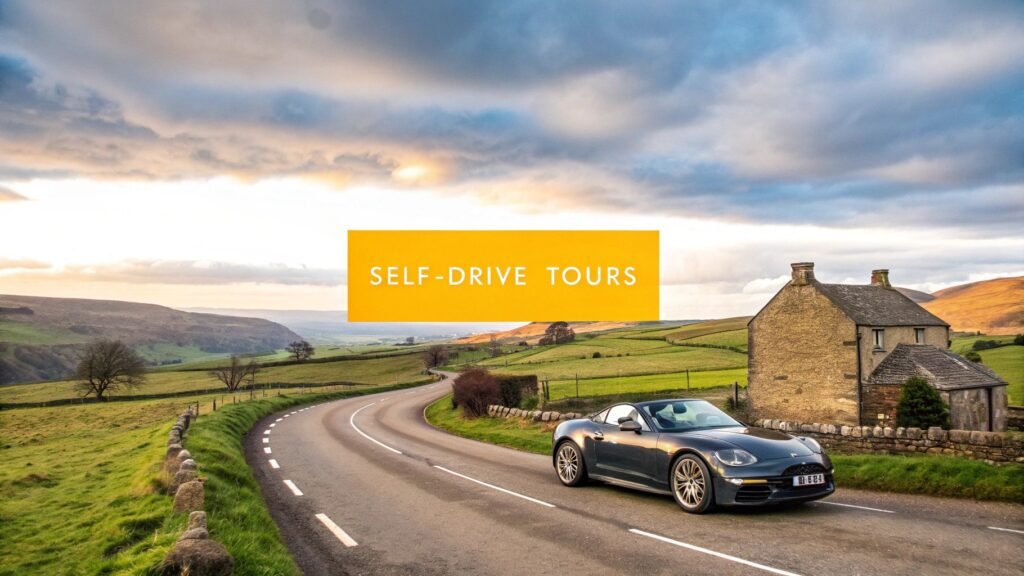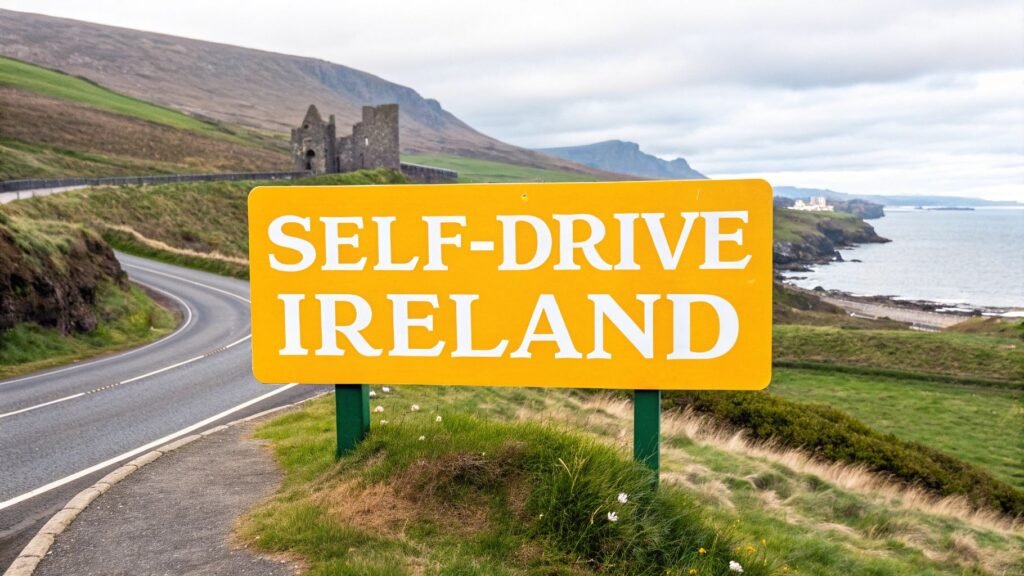Forget simple daily entries. A well-crafted travel journal stands as a tangible, personal testament to your adventures. But how do you capture the true essence of a journey: the specific flavour of a local dish, the sound of a bustling market, or the feeling of a dramatic mountain view? This guide moves beyond basic diaries to explore inventive and creative travel journal ideas that transform your memories into lasting works of art. It is designed for cultural explorers, independent travellers, and families seeking to document their trips in a more meaningful way.
We will delve into eight distinct, actionable approaches that cater to different personal styles. You will discover practical methods for everything from interactive map journaling and sensory documentation to creating a digital hybrid journal that blends the best of both worlds. Whether you are a budding artist, a meticulous planner, or a natural storyteller, you will find a method here that resonates with your creative spirit. Prepare to document your next trip, perhaps a self-drive tour through the Scottish Highlands, in a way that is as unique and memorable as the journey itself. This article provides the framework to get you started, moving you past the blank page and into a richer form of memory-keeping.
1. Visual Art Travel Journaling
Visual Art Travel Journaling is a wonderfully immersive method for capturing the essence of your travels, prioritising drawing, painting, and mixed media over extensive written notes. This approach transforms your journal into a gallery of personal experiences, using artistic expression to document the world around you. Instead of just describing a bustling marketplace, you can sketch the vibrant scene, capturing the movement, characters, and colours in a way words alone cannot.
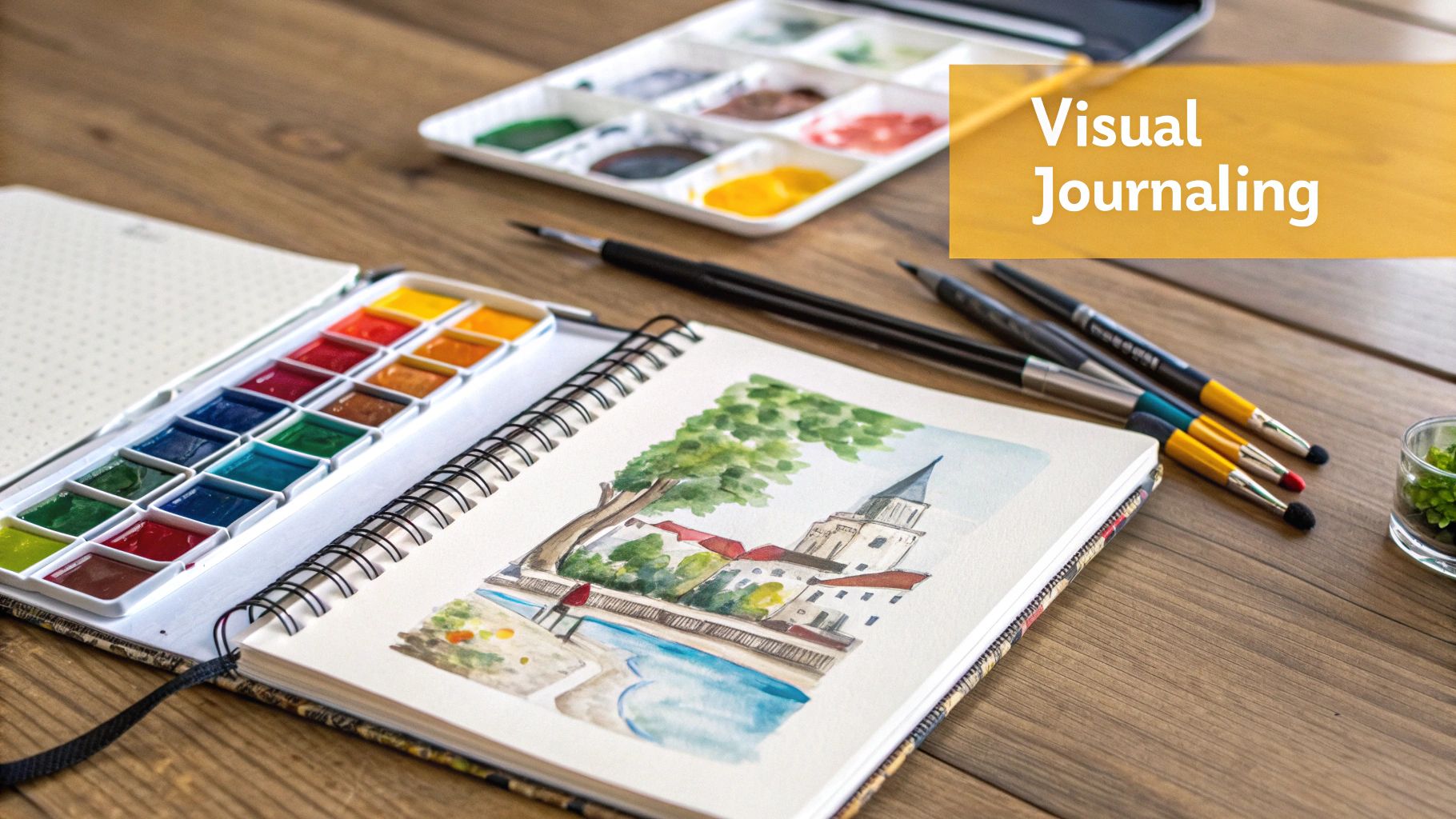
This creative travel journal idea is perfect for those who connect with their surroundings visually. It encourages you to slow down and truly see the architectural details of a historic cathedral, the unique textures of local cuisine, or the subtle shift of light over a landscape. The global community of Urban Sketchers, founded by Gabriel Campanario, is a testament to this method’s power, with artists documenting their cities and travels one drawing at a time.
How to Get Started with Visual Journaling
Getting started is less about being a professional artist and more about embracing the process. The goal is personal record-keeping, not a masterpiece for a gallery.
- Gather Your Tools: Invest in a portable watercolour set, a few waterproof ink pens (like Micron or Faber-Castell), and a sketchbook with quality watercolour paper that won’t buckle.
- Practise at Home: Before your trip, try sketching simple objects around your house. Draw your coffee cup, a piece of fruit, or the view from your window to build confidence.
- Focus on Details: Feeling overwhelmed by a grand vista? Start small. Sketch an interesting doorway, a colourful plate of food, or a single flower. These small studies often capture a more intimate sense of place.
Key Insight: Embrace imperfection. A wobbly line or a paint smudge isn’t a mistake; it’s part of your authentic experience and memory of that moment. Artists like Chandler O’Leary have built entire careers on this authentic, illustrated style.
2. Interactive Map Journaling
Interactive Map Journaling is a geographically-focused method that turns a standard map into a dynamic, personalised record of your journey. Instead of being just a navigational tool, the map becomes the canvas for your travel story. This approach involves marking your route, adding symbols for specific memories, and layering notes directly onto the cartographic layout, creating a visual and contextual log of your adventures.
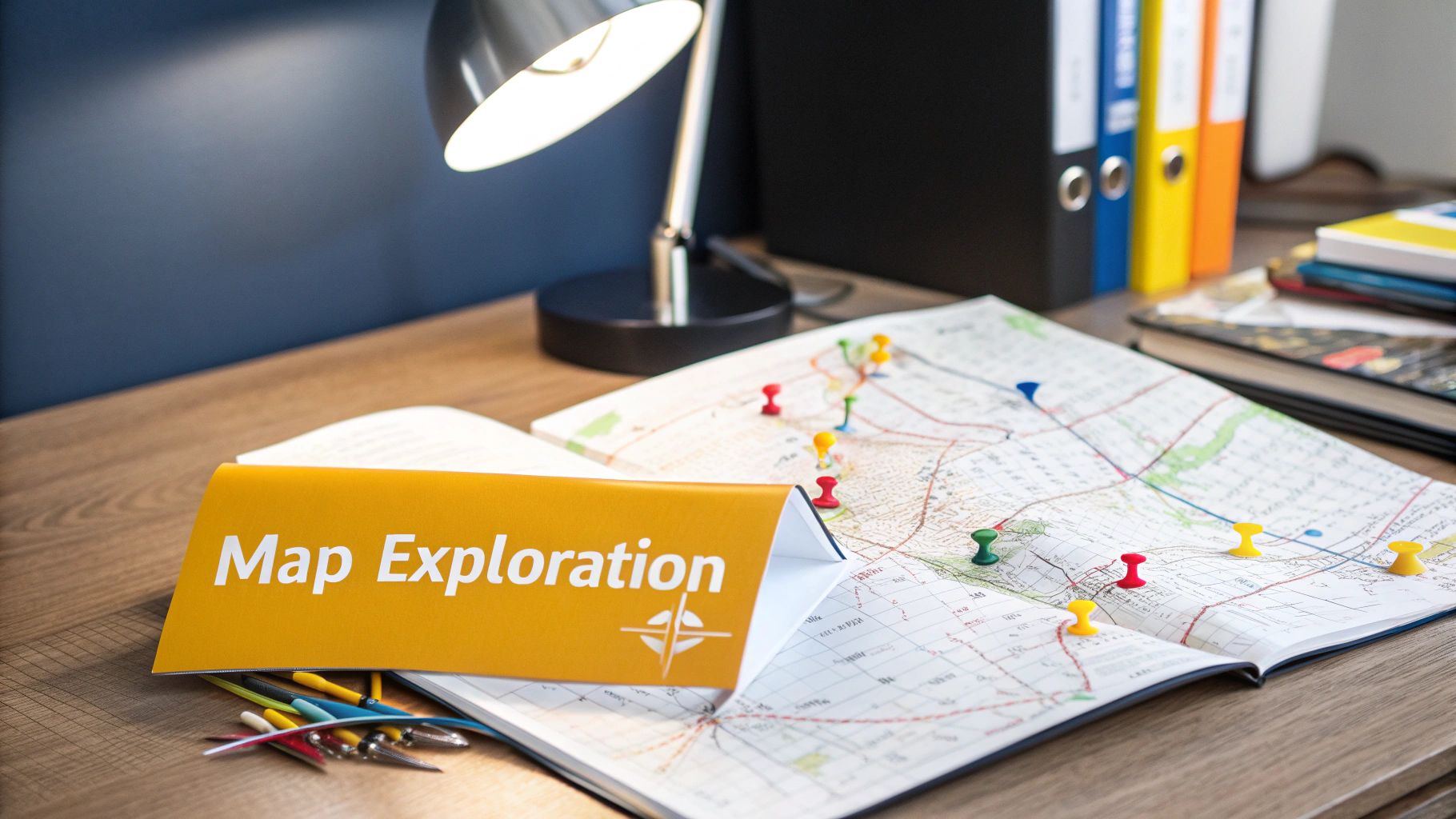
This creative travel journal idea is ideal for road-trippers, hikers, and anyone who loves to visualise their travels spatially. It brings your journey to life by connecting experiences to their precise locations. You can see at a glance where you had that incredible meal, where you spotted rare wildlife, or the scenic viewpoint that took your breath away. This technique is popular within communities like the Midori Traveler’s Notebook enthusiasts and is a core practice for many adventure travel bloggers documenting overlanding expeditions.
How to Get Started with Map Journaling
The beauty of this method is its simplicity and adaptability. You don’t need artistic skills, just a map and a desire to document your trip in a uniquely geographic way.
- Choose Your Foundation: Start with a good quality paper map of your destination. This could be a detailed city map, a regional road map, or even a trail map from a national park.
- Develop a Legend: Before you start, create a key or legend for your symbols. For example, a knife and fork for a memorable restaurant, a tent for a campsite, or a camera for a great photo spot. This keeps your map organised.
- Mark as You Go: Add to your map in real-time. Use different coloured archival-quality pens to draw your route, mark locations, and jot down short notes in the margins. This makes the process an active part of your travel.
Key Insight: Your map journal doesn’t have to be limited to the physical page. You can integrate digital elements by adding QR codes that link to online photo galleries, blog posts, or even a specific song you listened to on a particular stretch of road.
3. Sensory Experience Documentation
Sensory Experience Documentation is a multi-sensory approach to travel journaling that moves beyond just what you see. This creative travel journal idea encourages you to capture the full atmosphere of a place by consciously documenting sounds, smells, tastes, textures, and your own emotional responses. It’s about creating a richer, more immersive record that can trigger powerful memories years later. Instead of just writing that you visited a spice market, you would describe the pungent aroma of turmeric, the rough texture of burlap sacks, and the cacophony of vendors’ calls.
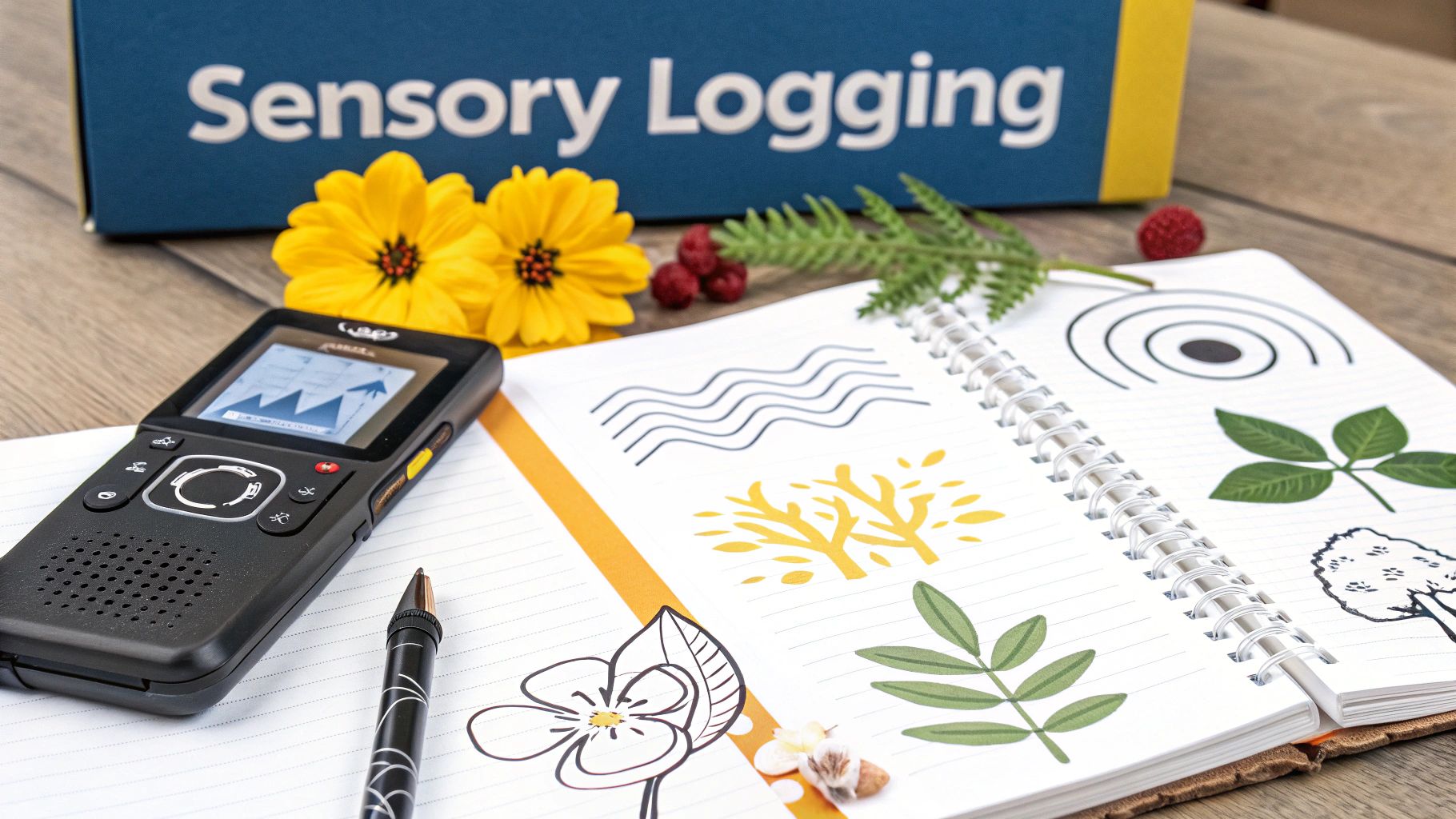
This method is perfect for travellers who want a deeper connection to their environment. It’s championed by culinary travel writers who document intricate flavour profiles, and sound artists who create “soundscapes” of different locations. By focusing on all five senses, you transform your journal from a simple log of events into a holistic time capsule of a specific moment and place, providing a much more complete representation of your travel experiences.
How to Get Started with Sensory Documentation
Engaging all your senses requires a deliberate shift in awareness. The goal is to notice the details that are often overlooked in our visually dominated world.
- Create Sensory Prompts: Dedicate a page to each sense. For ‘Sound’, list what you hear, from distant church bells to the crunch of gravel underfoot. For ‘Taste’, describe the sweet, sour, and savoury notes of a local dish.
- Practise Mindful Observation: Before your trip, take five minutes to sit quietly and document the sensory details of your current location. This trains your brain to notice more than just the visual cues.
- Use Collection Envelopes: Attach small glassine envelopes or pockets to your journal pages to hold physical sensory reminders. This could be a pinch of sand from a beach, a pressed flower, or a small fabric sample from a local market.
Key Insight: Develop a personal vocabulary for non-visuals. Instead of just “smelled good,” try “a sweet, earthy scent like petrichor after a warm rain.” Being specific makes the memory more vivid.
4. Digital Hybrid Journaling
Digital Hybrid Journaling is a modern approach that merges the tactile satisfaction of a physical notebook with the powerful capabilities of digital technology. This method allows you to create a rich, multimedia travel record, combining handwritten notes and pasted ephemera with QR codes linking to photo galleries, audio clips of market sounds, or video snippets of a stunning sunset. Instead of choosing between a pen and a screen, you use them together to build a more dynamic and interactive story of your journey.

This creative travel journal idea is ideal for the tech-savvy traveller who loves the feel of a traditional journal but doesn’t want to sacrifice the convenience of digital media. It’s a system embraced by digital nomads and travel bloggers who need an efficient way to organise vast amounts of content. For example, a simple journal entry about a day trip can be enhanced with a QR code that opens a Google Photos album from that day, instantly bringing the memory to life. This approach suits various travel styles, from solo explorers to families wanting a collaborative memory bank.
How to Get Started with Digital Hybrid Journaling
The key to a successful hybrid journal is creating a seamless workflow between your physical and digital worlds. It’s about making technology work for you, not the other way around.
- Choose Your Tools: Pair a quality notebook like a Moleskine or Traveler’s Notebook with a smartphone. Use apps like Journey for digital entries, Google Photos for image organisation, and a free QR code generator to create links.
- Establish an Organisation System: Create a consistent file naming convention for your digital assets (e.g., YYYY-MM-DD_Location_Description). When integrating diverse digital elements, using dedicated personal cloud storage solutions ensures your high-resolution photos and videos are safe and accessible.
- Start Small: Begin by adding one digital element per journal entry. Write about your favourite meal and stick in a QR code linking to a photo of the dish. This simple act builds the habit without feeling overwhelming.
Key Insight: The goal isn’t to digitise everything, but to enhance the physical record. Use digital tools to capture things paper cannot, like the sound of ocean waves or a 360-degree view, making your journal a true portal back to the moment.
5. Collection-Based Memory Keeping
Collection-Based Memory Keeping is a wonderfully tactile approach that turns your travel journal into a personal museum of your adventures. This method prioritises gathering physical mementos and artistically integrating them into your pages, allowing everyday objects to become powerful triggers for your travel memories. Instead of just writing about your train journey, you can paste the actual ticket alongside your notes, instantly reconnecting you to that specific moment in time.
This creative travel journal idea is perfect for those who love souvenirs and tangible connections to their experiences. It encourages you to see the potential story in a foreign coin, a colourful sugar packet, a pressed flower from a national park, or a vintage postcard found in a local market. Popularised within scrapbooking communities and by archivists, this method transforms ephemera into a curated, chronological narrative of your trip.
How to Get Started with Collection-Based Journaling
The key to this style is organising your collected treasures in a way that tells a story, rather than just creating a cluttered scrapbook. The focus is on curation and meaningful presentation.
- Gather Your Tools: You will need a sturdy journal that can handle bulky items, acid-free glue or photo corners, and clear pockets or envelopes. A small, labelled folder is useful for organising items during your travels.
- Curate with Intention: You cannot keep everything. Be selective about what you collect, focusing on items that hold a specific memory or represent the local culture, such as a local bus ticket, a beer bottle label, or a receipt from a memorable meal.
- Design Your Layouts: Create dedicated spaces for different types of items. You could have a page for transportation tickets, a section for currency with notes on the exchange rate, or a spread showcasing pressed flowers from different regions. Note the date, location, and significance of each item.
Key Insight: Preservation is key. Use archival-quality, acid-free adhesives to prevent your mementos from yellowing or deteriorating over time. This ensures your collected memories last as long as your written ones.
6. Cultural Immersion Language Learning Journal
A Cultural Immersion Language Learning Journal is a specialised approach that transforms your travelogue into a dynamic tool for language acquisition. It focuses on documenting your linguistic journey, from new vocabulary and grammar rules to the cultural nuances that give a language its soul. Instead of simply noting what you did, you record how you communicated, the phrases you learned, and the cultural context behind the words.
This creative travel journal idea is perfect for anyone wanting to connect with a destination on a deeper level. It’s used extensively by polyglots, study abroad students, and cultural anthropologists to systematically track their progress and understanding. By dedicating pages to language, you create a powerful, personalised textbook based on your direct experiences, such as ordering food, asking for directions, or sharing a joke with a local.
How to Get Started with a Language Learning Journal
The focus here is practical application, not academic perfection. Your journal is a safe space to practise and make mistakes as you learn.
- Organise by Theme: Dedicate sections to specific scenarios, like “At the Restaurant,” “Navigating Public Transport,” or “Shopping at the Market.” This organises vocabulary in a practical way. Exploring a destination’s food scene can be a fantastic way to practise; a culinary indulgence tour of Ireland offers countless opportunities to learn new words and phrases.
- Create a Two-Column Layout: On one side, write the new word or phrase in the local language. On the other, note its translation, a simple phonetic spelling to help with pronunciation, and the context where you first heard it.
- Document Your Interactions: Briefly write about a conversation you had, even a simple one. What did you try to say? What did you understand? What did you learn from the exchange? This turns abstract learning into a concrete memory.
Key Insight: Don’t just collect words; collect experiences. Noting that “merci” means “thank you” is good, but remembering the elderly baker who said it with a warm smile after you bought a croissant is what truly embeds the language in your memory.
7. Adventure Activity Documentation Journal
An Adventure Activity Documentation Journal is a specialised and systematic approach for active travellers who want to record their physical feats and outdoor experiences. Rather than focusing on broad travel narratives, this method zeroes in on the technical and personal details of each activity, from rock climbing to long-distance cycling. It functions as a logbook, a performance tracker, and a space for reflection all in one.
This creative travel journal idea is perfect for anyone whose travels are defined by action. It provides a framework for tracking progress, analysing performance, and remembering crucial details like trail conditions or gear effectiveness. For example, a hiking log might include trail names, distances, elevation gain, and notes on how your new boots performed, while a scuba diving journal would document dive sites, water visibility, and marine life spotted. This method is popularised by adventure sports communities, where such detailed logs are invaluable for skill development and safety.
How to Get Started with Adventure Documentation
Creating an adventure journal is about establishing a consistent system that captures the data most important to you. The goal is to build a detailed record that is both practical and meaningful.
- Design Your Template: Before you leave, create a template for your activities. For a hiking trip, this could include fields for Date, Trail Name, Distance, Elevation, Time, Weather, and a section for notes. Consistency is key to tracking your progress over time.
- Log the Technicals: Be specific. Instead of just writing “went rock climbing,” note the route name, its difficulty grade, the type of climb (e.g., top-rope, lead), and any specific techniques you used or struggled with.
- Balance Data with Reflection: While the technical details are crucial, don’t forget to record how the activity felt. Document your emotional state, what you learned, and the sense of accomplishment. Combining hard data with personal reflection creates a richer memory. Exploring organised trips can often introduce you to new activities perfect for this style of journaling; you can find inspiration for your next challenge by reviewing different adventure group tours.
Key Insight: Your journal is a tool for future adventures. By documenting gear performance and lessons learned (“Note to self: these socks cause blisters after 10km”), you are actively preparing yourself to be a safer, more efficient, and more competent adventurer on your next outing.
8. Themed Storytelling and Narrative Journaling
Themed Storytelling and Narrative Journaling elevates your travel diary from a simple log of events into a compelling, cohesive story. This creative travel journal idea involves structuring your experiences around a specific theme or narrative framework, much like a novelist or screenwriter would. Instead of just listing places you visited, you can weave your journey into a narrative, exploring themes of personal growth, historical discovery, or culinary adventure.
This approach is perfect for writers and those who want to find a deeper meaning in their travels. It encourages you to think about plot, character (with you as the protagonist), and thematic development. For instance, a trip through Italy could become a food-focused narrative of culinary transformation, while exploring ancient ruins in Greece could be framed as a historical mystery, incorporating local legends. This method is popularised by professional travel writers and the vibrant travel blogging communities that prioritise powerful storytelling.
How to Get Started with Narrative Journaling
The key to narrative journaling is to choose a lens through which to view and record your experiences. It’s less about strict factual reporting and more about capturing the emotional and thematic arc of your journey.
- Choose Your Theme: Before you leave, decide on a theme that genuinely resonates with you. This could be anything from an “adventure quest” filled with challenges to a “romance narrative” documenting a shared trip.
- Establish a Voice: Decide on your narrative perspective. Are you writing in the first person, as an objective observer, or perhaps even from the perspective of an object, like your trusty backpack?
- Outline a Basic Plot: Think about your trip in terms of a story: the beginning (the anticipation), the middle (the challenges and discoveries), and the end (the resolution and reflection). This structure helps organise your entries. To deepen your skills, studying the principles of storytelling in marketing can help you craft more engaging narratives.
Key Insight: Don’t be afraid to embellish for narrative effect, but remain true to the emotional core of your experience. The goal is to create a compelling story that captures the spirit of your travels, not a perfectly factual report.
Creative Travel Journal Ideas Comparison
| Travel Journaling Method | Implementation Complexity 🔄 | Resource Requirements ⚡ | Expected Outcomes 📊 | Ideal Use Cases 💡 | Key Advantages ⭐ |
|---|---|---|---|---|---|
| Visual Art Travel Journaling | Moderate to High 🔄 | Artistic supplies, skills required ⚡ | Unique visual memories, artistic growth 📊 | Artistic travelers, slow-paced journaling 💡 | Personalized artwork, language-independent ⭐ |
| Interactive Map Journaling | Moderate 🔄 | Physical maps, markers, stickers ⚡ | Clear geographic context, organized logs 📊 | Geography enthusiasts, route planning 💡 | Visual appeal, spatial clarity ⭐ |
| Sensory Experience Documentation | High 🔄 | Audio recorders, collection tools ⚡ | Rich sensory memories, mindfulness 📊 | Multi-sensory learners, immersive journaling 💡 | Vivid memory triggers, non-visual capture ⭐ |
| Digital Hybrid Journaling | High 🔄 | Tech devices, internet, apps ⚡ | Multimedia records, easy sharing 📊 | Tech-savvy travelers, collaborative journaling 💡 | Backup options, multimedia storytelling ⭐ |
| Collection-Based Memory Keeping | Moderate 🔄 | Physical storage, adhesives ⚡ | Tangible souvenirs, textured pages 📊 | Souvenir collectors, scrapbooking fans 💡 | Authentic artifacts, conversation starters ⭐ |
| Cultural Immersion Language Learning | High 🔄 | Language tools, study time ⚡ | Accelerated language skills, cultural insight 📊 | Language learners, cultural immersion 💡 | Cross-cultural communication, valuable references ⭐ |
| Adventure Activity Documentation Journal | Moderate to High 🔄 | Specialized gear knowledge ⚡ | Skill tracking, safety records 📊 | Adventure travelers, sport enthusiasts 💡 | Detailed gear and route logs, achievement tracking ⭐ |
| Themed Storytelling and Narrative Journaling | High 🔄 | Writing skills, time ⚡ | Engaging stories, creative growth 📊 | Writers, storytellers, personal reflection 💡 | Shareable narratives, literary portfolio ⭐ |
Start Your Creative Journey Today
Your travel journal is more than just a record of places visited; it is a canvas for your personal experience, a tangible piece of your journey that grows richer with every entry. Throughout this guide, we have explored a diverse range of creative travel journal ideas, moving far beyond the simple day-by-day diary. From the vibrant strokes of a Visual Art Journal to the dynamic routes of Interactive Map Journaling, each concept offers a unique lens through which to capture your adventures.
We’ve delved into how to document the world through your senses with Sensory Experience Journaling and how to blend tradition with technology in a Digital Hybrid Journal. You now have the tools to curate your own story, whether it’s through a Collection-Based Memory Journal filled with tangible ephemera or a Cultural Immersion Journal that tracks your linguistic progress. For the thrill-seekers, the Adventure Activity Journal provides a framework for capturing every exhilarating moment, while the Themed Storytelling Journal helps weave your individual experiences into a cohesive and compelling narrative.
Your Personalised Path to Memory Keeping
The true power of these concepts lies not in rigid adherence, but in creative combination. The most memorable and meaningful travel journals are those that reflect the unique personality of their creator.
Consider these hybrid approaches for your next trip:
- Combine Art and Narrative: Paste your ticket stub from a historic castle tour next to a quick watercolour sketch of its battlements, and then write a short, fictional story from the perspective of a person who once lived there.
- Integrate Maps and Senses: On your interactive map, don’t just mark the restaurant where you ate. Add a small note describing the flavour of the local dish, the sound of the bustling street outside, and the aroma of spices in the air.
- Merge Digital and Analogue: Print a small photo from your phone and paste it into your physical journal. Beside it, add a QR code that links to a video of that moment or to a digital playlist of music you discovered on your travels.
The goal is not perfection; it’s expression. Your journal is a private space for exploration and reflection. A smudge of paint or a hastily written note often holds more authentic emotional weight than a perfectly curated page. The key is to start, to allow yourself to play, and to find the methods that genuinely resonate with you.
By actively engaging with your surroundings in this way, you are not just passively observing; you are deepening your connection to the places you visit. You transform from a tourist into a storyteller, an artist, and an archivist of your own life’s adventures. The result is a priceless keepsake, a deeply personal artefact that will transport you back to the sights, sounds, and feelings of your journey for many years to come. Your story is waiting to be told, pick up a pen, a brush, or a map, and start writing it.
Ready to plan an adventure worthy of its own creative journal? Explore the bespoke self-drive tours offered by BTOURS and discover the rich history, culture, and landscapes of Ireland and the UK at your own pace. Let us handle the details so you can focus on creating and capturing unforgettable memories. Find your perfect journey at BTOURS today.


